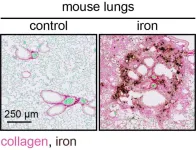(Press-News.org) Strictly embargoed until 0900 ET Thursday 14 December 2023
Increased sedentary time in childhood can raise cholesterol levels by two thirds as an adult, leading to heart problems and even premature death - but a new study has found light physical activity may completely reverse the risks and is far more effective than moderate-to-vigorous physical activity.
The study was conducted in collaboration between the University of Exeter, University of Eastern Finland, and University of Bristol and published in The Journal of Clinical Endocrinology & Metabolism. Researchers used data from the University of Bristol study Children of the 90s (also known as the Avon Longitudinal Study of Parents and Children), which included 792 children aged 11 years who were followed up until the age of 24.
Results from this study found that accumulated sedentary time from childhood can increase cholesterol levels by two thirds (67 percent) by the time someone reaches their mid-twenties. Elevated cholesterol and dyslipidaemia from childhood and adolescence have been associated with premature death in the mid-forties and heart problems such as subclinical atherosclerosis and cardiac damage in the mid-twenties.
Healthy lifestyles are considered important in the prevention of dyslipidaemia and one of the primary ways of lowering cholesterol, apart from diet, is movement behaviour. For the first time, this study objectively examined the long-term effects of sedentary time, light physical activity, and moderate-to-vigorous physical activity on childhood cholesterol levels.
The World Health Organization currently recommends children and adolescents should accumulate on average 60 minutes of moderate-to-vigorous physical activity a day and reduce sedentary time but have limited guidelines for light physical activity. Yet this new study and other recent studies has found light physical activity – which includes exercises such as long walks, house chores, or slow dancing, swimming, or cycling – is up to five times more effective than moderate-to-vigorous physical activity at promoting healthy hearts and lowering inflammation in the young population.
Dr Andrew Agbaje from the University of Exeter led the study and said: “These findings emphasise the incredible health importance of light physical activity and shows it could be the key to preventing elevated cholesterol and dyslipidaemia from early life. We have evidence that light physical activity is considerably more effective than moderate-to-vigorous physical activity in this regard, and therefore it’s perhaps time the World Health Organization updated their guidelines on childhood exercise - and public health experts, paediatricians, and health policymakers encouraged more participation in light physical activity from childhood.”
During the research, accelerometer measures of sedentary time, light physical activity, and moderate-to-vigorous physical activity were collected at ages 11, 15, and 24 years. High-density lipoprotein cholesterol, low-density lipoprotein cholesterol, triglyceride, and total cholesterol were repeatedly measured at ages 15, 17, and 24 years. These children also had repeated measurement of dual-energy Xray absorptiometry assessment of total body fat mass and muscle mass, as well as fasting blood glucose, insulin, and high sensitivity C-reactive protein, with smoking status, socio-economic status, and family history of cardiovascular disease.
During the 13-year follow-up, sedentary time increased from approximately six hours a day to nine hours a day. Light physical activity decreased from six hours a day to three hours a day while moderate-to-vigorous physical activity was relatively stable at around 50 minutes a day from childhood until young adulthood. The average increase in total cholesterol was 0.69 mmol/l. It was observed without any influence from body fat.
An average of four-and-a-half hours a day of light physical activity from childhood through young adulthood causally decreased total cholesterol by (-0.53 mmol/l), however, body fat mass could reduce the effect of light physical activity on total cholesterol by up to six percent. Approximately 50 minutes a day of moderate-to-vigorous physical activity from childhood was also associated with slightly reduced total cholesterol (-0.05 mmol/L), but total body fat mass decreased the effect of moderate-to-vigorous physical activity on total cholesterol by up to 48 percent. Importantly, the increase in fat mass neutralised the small effect of moderate-to-vigorous physical activity on total cholesterol.
The paper is entitled Associations of Sedentary Time and Physical Activity from Childhood with Lipids: A 13-Year Mediation and Temporal Study and published in The Journal of Clinical Endocrinology & Metabolism. These findings come shortly after another study led by Dr Andrew Agbaje published this week in Nature Communications found light physical activity may completely reverse childhood obesity linked to increased sedentary time in more than 6000 children. Sedentary time contributed seven to ten percent of the total fat mass gained during growth from childhood until young adulthood. Light physical activity decreased the overall gain in fat mass by 9.5–15 percent, while moderate-to-vigorous physical activity decreased fat mass by 0.7–1.7 percent.
Dr Andrew Agbaje of the University of Exeter said: “Our research suggests light physical activity may be an unsung hero and it is about time the world replaced the mantra of ‘an average of 60 minutes a day of moderate-to-vigorous physical activity’ with ‘at least 3 hours a day of light physical activity’. Light physical activity appears to be the antidote to the catastrophic effect of sedentary time in the young population.”
Dr Andrew Agbaje’s research group (urFIT-child) is supported by research grants from Jenny and Antti Wihuri Foundation, the Finnish Cultural Foundation Central Fund, the Finnish Cultural Foundation North Savo Regional Fund, the Orion Research Foundation, the Aarne Koskelo Foundation, the Antti and Tyyne Soininen Foundation, the Paulo Foundation, the Yrjö Jahnsson Foundation, the Paavo Nurmi Foundation, the Finnish Foundation for Cardiovascular Research, Ida Montin Foundation, the Foundation for Pediatric Research, and Alfred Kordelin Foundation.
ENDS
END
High cholesterol caused by childhood sedentariness could be reversed with light physical activity
Increased sedentary time in childhood can raise cholesterol levels by two thirds as an adult, leading to heart problems and even premature death - but a new study has found light physical activity may completely reverse the risks and is far more effective
2023-12-14
ELSE PRESS RELEASES FROM THIS DATE:
Menstrual cycles affect day-to-day suicide risk, UIC researchers find
2023-12-14
Female patients with a history of suicidality experience an increased risk of suicidal ideation or suicidal planning in the days surrounding menstruation, according to a new study by researchers at the University of Illinois Chicago.
In the first longitudinal study of how suicidal thoughts and related symptoms fluctuate across the menstrual cycle, UIC researchers identified when some female patients are at the highest risk, offering new guidance for clinicians about when to focus interventions with suicidal patients.
“As clinicians, we feel responsible for keeping our patients safe from a suicide attempt, but we often don’t have much information about when we need ...
A novel low-cost unmanned aerial vehicle platform for electrical transmission line inspection
2023-12-14
Electricity is an indispensable resource for our daily lives; it powers our homes, industries, and agriculture, among other things. Electricity is generated in power plants that are often located in remote areas due to safety and environmental concerns. The generated electricity is then transported to residential and industrial areas through transmission lines. However, these remote locations pose challenges in terms of harsh environments that can easily damage the transmission lines. Therefore, regular inspection and maintenance of these lines are ...
Popular blood thinner associated with higher risk of bleeding complications
2023-12-14
When diagnosed with a blood clot or atrial fibrillation, patients are often prescribed anticoagulants, or blood thinners, to prevent a future clot.
In a study of the three most commonly prescribed blood thinners, the oral anticoagulant rivaroxaban, known by the brand name Xarelto, was associated with a significantly higher risk of bleeding complications than apixaban (brand name Eliquis) and warfarin for patients with blood clots or atrial fibrillation.
The findings, reported at the 2023 American Society ...
Study shows tree nuts as snacks reduces metabolic syndrome risk in Millenials
2023-12-14
DAVIS, CA, December 14, 2023 – A recent study published online in the journal, Nutrients[1], suggests daily tree nut consumption reduces the risk of metabolic syndrome (MetSx) by improving waist circumference, lipid biomarkers, and/or insulin levels, without requiring calorie restriction, in young adults.
In a randomized, parallel arm, dietary intervention study design, researchers at Vanderbilt University Medical Center enrolled 84 men and women, ages 22-36, most of whom were either overweight or obese (BMI 24.5 to 34.9 kg/m2) and had at least one MetSx risk factor ...
Pattern of alcohol intake more accurate indicator of liver disease risk than overall consumption
2023-12-14
Those who binge drink and have a certain genetic makeup are six times more likely to develop alcohol-related cirrhosis, according to new research from UCL, the Royal Free Hospital, the University of Oxford and the University of Cambridge.
The study, published in Nature Communications, is the first to assess how an individual’s pattern of drinking, their genetic profile (via a polygenic risk score) and whether or not they have type-2 diabetes affects their risk of developing alcohol-related cirrhosis (ARC).
The observation that pattern of drinking is more important than volume, coupled with the increased risk when genetic makeup and type-2 diabetes are also present, ...
Spinal cord stimulation reduces pain, improves balance in people with lower limb amputation
2023-12-14
PITTSBURGH, Dec. 14, 2023 – Spinal cord stimulation can elicit sensation in the missing foot and alleviate phantom limb pain in people with lower limb amputations, University of Pittsburgh School of Medicine rehabilitation scientists report today.
Pressure sensors on the insole of a prosthetic foot triggered electrical pulses that were then delivered to a participants’ spinal cord. Researchers found that this sensory feedback also improved balance and gait stability. The proof-of-concept study was done in collaboration with Carnegie Mellon ...
Eating meals early could reduce cardiovascular risk
2023-12-14
Cardiovascular diseases are the leading cause of death in the world according to the Global Burden of Disease study, with 18.6 million annual deaths in 2019, of which around 7.9 are attributable to diet. This means that diet plays a major role in the development and progression of these diseases. The modern lifestyle of Western societies has led to specific eating habits such as eating dinner late or skipping breakfast. In addition to light, the daily cycle of food intake (meals, snacks, etc.) alternating with periods of fasting synchronizes the peripheral clocks, or circadian rhythms, of the body’s various organs, thus ...
What do Gifted dogs have in common?
2023-12-14
All dog owners think that their pup is special. Science now has documented that some rare dogs are…even more special! They have a talent for learning hundreds of names of dog toys. Due to the extreme rarity of this phenomenon, until recently, very little was known about these dogs, as most of the studies that documented this ability included only a small sample of one or two dogs. In a new study published in the Journal Scientific Reports, researchers from the Family Dog Project (ELTE Eötvös Loránd University, Budapest) shed new light on the characteristics of these exceptional dogs.
In ...
Iron accumulation: a new insight into fibrotic diseases
2023-12-14
Researchers at IRB Barcelona reveal the pivotal role of iron accumulation in the development of fibrotic diseases and propose that iron detection via MRI can serve to diagnose fibrosis.
Fibrotic diseases account for 45% of all mortality in developed countries.
Published in Nature Metabolism, the study points to new therapeutic opportunities that target iron.
Barcelona, 14 December 2023 – Fibrosis is associated with various chronic and life-threatening conditions, including pulmonary fibrosis, liver cirrhosis, kidney disease, and cardiovascular diseases, ...
Facial symmetry doesn’t explain “beer goggles”
2023-12-14
If you thought blurry eyes were to blame for the “beer goggles” phenomenon, think again.
Scientists from the University of Portsmouth have tested the popular theory that people are more likely to find someone attractive while drunk, because their faces appear more symmetrical.
The term “beer goggles” has been used for decades to describe when a person finds themselves sexually attracted to someone while intoxicated, but not sober.
One possible explanation for the effect is that alcohol impairs the drinker’s ability to detect facial asymmetry, ...
LAST 30 PRESS RELEASES:
Making lighter work of calculating fluid and heat flow
Normalizing blood sugar can halve heart attack risk
Lowering blood sugar cuts heart attack risk in people with prediabetes
Study links genetic variants to risk of blinding eye disease in premature infants
Non-opioid ‘pain sponge’ therapy halts cartilage degeneration and relieves chronic pain
AI can pick up cultural values by mimicking how kids learn
China’s ecological redlines offer fast track to 30 x 30 global conservation goal
Invisible indoor threats: emerging household contaminants and their growing risks to human health
Adding antibody treatment to chemo boosts outcomes for children with rare cancer
Germline pathogenic variants among women without a history of breast cancer
Tanning beds triple melanoma risk, potentially causing broad DNA damage
Unique bond identified as key to viral infection speed
Indoor tanning makes youthful skin much older on a genetic level
Mouse model sheds new light on the causes and potential solutions to human GI problems linked to muscular dystrophy
The Journal of Nuclear Medicine ahead-of-print tip sheet: December 12, 2025
Smarter tools for peering into the microscopic world
Applications open for funding to conduct research in the Kinsey Institute archives
Global measure underestimates the severity of food insecurity
Child survivors of critical illness are missing out on timely follow up care
Risk-based vs annual breast cancer screening / the WISDOM randomized clinical trial
University of Toronto launches Electric Vehicle Innovation Ontario to accelerate advanced EV technologies and build Canada’s innovation advantage
Early relapse predicts poor outcomes in aggressive blood cancer
American College of Lifestyle Medicine applauds two CMS models aligned with lifestyle medicine practice and reimbursement
Clinical trial finds cannabis use not a barrier to quitting nicotine vaping
Supplemental nutrition assistance program policies and food insecurity
Switching immune cells to “night mode” could limit damage after a heart attack, study suggests
URI-based Global RIghts Project report spotlights continued troubling trends in worldwide inhumane treatment
Neutrophils are less aggressive at night, explaining why nighttime heart attacks cause less damage than daytime events
Menopausal hormone therapy may not pose breast cancer risk for women with BRCA mutations
Mobile health tool may improve quality of life for adolescent and young adult breast cancer survivors
[Press-News.org] High cholesterol caused by childhood sedentariness could be reversed with light physical activityIncreased sedentary time in childhood can raise cholesterol levels by two thirds as an adult, leading to heart problems and even premature death - but a new study has found light physical activity may completely reverse the risks and is far more effective



